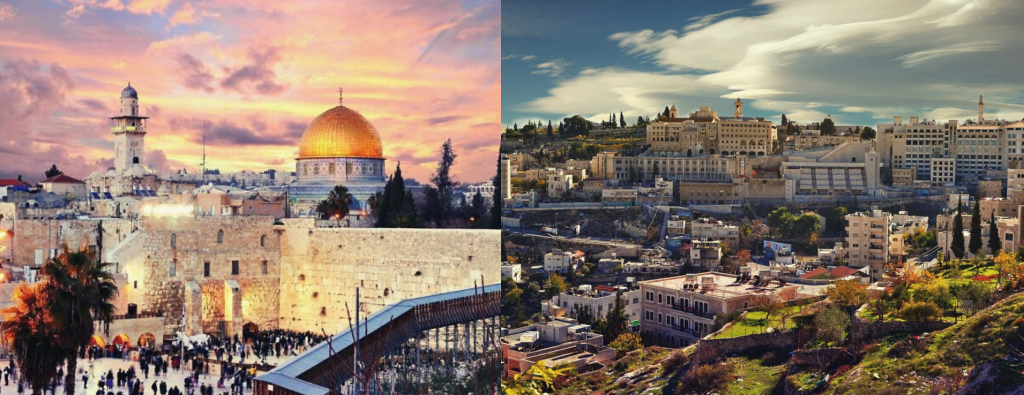Just Nine Miles

Actually, it may be fewer than that today, more like six miles. I’m speaking of the distance to Bethlehem from Jerusalem. Even I could walk that distance if need be. And I think the time has come. In fact, it came a long time ago and has now become urgent.
When I visited pre-pandemic Bethlehem and Jerusalem last February, I was as struck as any visitor is likely to be at the differences between the two. The obvious is size: Jerusalem huge, looming in wealth and power, over tiny, walled-in shabby Bethlehem. Jerusalem, glittering in beauty around the sites we saw and the neighborhoods hosting us, projected confidence, sufficiency, prosperity; Bethlehem, more teeming with more chaotic life, scrabbling to make do rather than boasting of achieved success – at least in the parts we saw traveling up to and around the Church of the Holy Sepulchre. Both cities evoked strong emotions, and both offered very different enticements.
What if we had to choose between them? What if we are choosing between them? To which one are those nine miles leading us?
Our traditional Catholic Church seems more like Jerusalem. In its most magnificent manifestations, it is glittery, decked out, in love with the ancient in and of itself and, of course, with its own ancient history, rock-hard, shored up and self-assured in the midst of threats and dangers, a power allying with powers…and yet so heart-renderingly beautiful – and so central to all of our own stories.
Our more non-traditional Catholic alternative choices, mainly community gatherings, scattered local small Eucharistic communities, house churches, collectives, and, today of course, Zooms, seem more like Bethlehem. In their own magnificent manifestations, they are diverse and diversified, a bit chaotic at times, somewhat unpredictable, devoid of power structure and dogma, blending the wisdom of the ages with everyday revelations, wanting faith, rather than The Faith, to survive.
Like the wise men and women and other gendered, those three kings, or maybe queens for all we know, we will be taking our own treasures…where? The prophet Isaiah points us toward Jerusalem which, even if ravaged or torn down, we must rebuild and make glorious and powerful once again. But the prophet Micah directs us to Bethlehem to find the model for renewal and sustenance: But you, O Bethlehem, David’s country, the runt of the litter – From you will come the leader who will shepherd-rule Israel.” (Micah 5:2-4)
Which way do we go? They are only nine miles – and a whole world – apart.
Maybe we decide based on leadership and ministry. Where and by whom, for example, can the Holy word be spoken and interpreted? Where and by whom can the Holy Eucharist be consecrated and the Holy Presence evoked? Only in great temples? Only by officially recognized and anointed male priests? Or in small gatherings with people like the Christmas story’s shepherds, so powerless they were not even counted in Caesar’s census, with the workers and the women, like Joseph and Mary, soon to be refugees, and with who knows how many others of whatever gender and background and status. Who would say the Holy words there and what could they be? The possibilities are endless. Who would consecrate the food and wine of our lives so that it transubstantiates into Holy Eucharist? Perhaps women (along with all others), women like Mary who, in that same story, just brought “Real Presence” into life literally with her own body as we, if that is our life choice, also do?
The absurdity of the questions themselves points us irrevocably toward the answer. Much as I love Jerusalem and will visit there many times, it is Bethlehem that has my heart and mind.
We are traveling those nine miles as I write – and not only in the Church. We are making choices on which our very lives depend, all of our very lives, right now.
Theologian, Walter Brueggemann, wrote about the choice this way:
The narrative of Epiphany is the story of these two human communities: Jerusalem, with its great pretensions, and Bethlehem, with its modest promises. We can choose a “return to normalcy” in a triumphalist mode, a life of self-sufficiency that contains within it its own seeds of destruction. Or we can choose an alternative that comes in innocence and a hope that confounds our usual pretensions. We can receive life given in vulnerability. It is amazing — the true accent of epiphany — that the wise men do not resist this alternative but go on to the village. Rather than hesitate or resist, they reorganize their wealth and learning, and reorient themselves and their lives around a baby with no credentials.
Bethlehem is nine miles south of Jerusalem. The wise men had a long intellectual history of erudition and a long-term practice of mastery. But they had {almost} missed their goal by nine miles. It is mind-boggling to think how the story might have gone…..

2 Responses
This is a wonderful post, Ellie! You make such good use of your international travel, to shows us the contrast between Jerusalem and Bethlehem, which was probably nearly as dramatic when the 3 Kings were in the area as it is now. It is an apt metaphor to describe the difference between the cathedrals and the small communities like CCS. Thanks for sharing your ideas with all of us.
Thank you for sharing, Elsie.
Wish you a better year to come. Still on Whidbey Island in Washington.